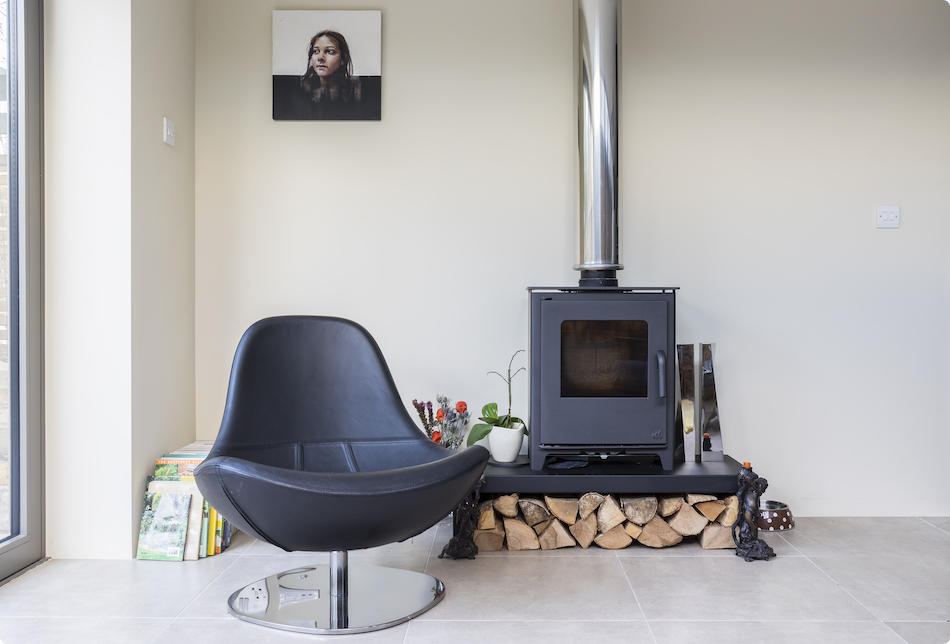In terms of design and how they operate, multi-fuel stoves work in pretty much the same way as their wood-burning counterparts. However, because they use a wider range of fuels, you’ll have a larger range of suppliers to choose from. This means you can choose a fuel that is both convenient to obtain and the most cost-effective. Something to consider, if you think a good supply of wood might be hard to come by.
And don’t worry if you don’t have a chimney already in place, in such cases you can get a special insulated stainless steel pipe fitted to let out the smoke. Naturally, this will be most costly but you can’t have fire without smoke!
The benefits of installing a log burning stove
There’s a reason why log burners have become so popular. Check out the benefits they could have for your home…
Eco-friendly
Log burners don’t just have to be there to look nice, they can also heat both your home and your water supply. This gives them the potential to be an incredible way of lowering your carbon footprint. How?
If you use gas and electric equivalents that get their power from fossil fuels, they’ll produce on average 0.198 kg and 0.517 kg of CO2 per kWh respectively. In comparison, an eco-friendly wood burning stove only generates 0.008 kg of CO2.
Cut your bills
Needless to say, by using a log burner to heat your home, you could save money in the long run from a reduction in household bills.
Of course, this might not be the case if the cost of fuel is too much day to day or if your home is too big to heat from one log burner. But even if you use your stove in conjunction with central heating, you could still save money.
60% of people surveyed by Which?* said their wood-burning stove, which they use alongside their central heating system, had saved them money.
Increased well-being
The light in our home makes a big difference to our well-being. Science has shown that while blue, bright light is good for productivity, it’s not great for our downtime. If you want to help create a sense of calm, the glow from a fireplace can’t be beat. Chilling out in the orange lighting provided by your log-burner will not only relieve stress, it can also promote a better night’s sleep.

The downsides
Upfront costs
The price of wood burners can vary massively, depending on the whether your home is suitable for installation, plus the make and model you choose. Prices can start as low as £400 but also go all the way up to £4000. However, on average, when you’re including installation, you’ll be looking at around the £1500 mark.
For some, this upfront cost can be off-putting.
Smoke restrictions
Because of the polluting effect smoke can have, many cities are now introducing smoke controlled areas. Those who live in these spaces will have to use a Defra approved stove which is specifically designed to be eco-friendly. If you don’t have a stove of this kind, you’ll have to switch your fuel to an approved smokeless variety.
Want to know if you’re in a smoke controlled area? The government doesn’t have any clear guidance on this issue, so you’ll need to phone up your local authority to find out.
What wood should I use?
In order to keep smoke to a minimum, you can’t just burn any old branch.
As a rule, make sure your wood is as dry as possible. The ideal would be wood that contains 20% or less water. For context, freshly cut wood contains 60% or more moisture.
Therefore, if you want to buy ready to burn fuel, you should aim for well-seasoned hardwood logs, thoroughly dried. Too expensive? Your other option is to purchase green wood and dry it yourself at home, though this will require a shed or barn to do so.
If this isn’t doable, an even more eco-friendly version will be briquettes. Briquettes produce 50% more heat than a traditional log and are made from compacted pieces of old waste wood, usually gathered from old furniture.
Building regulations
If you live in the UK, you will need sign-off from building control before you can go ahead and enjoy that fire. You can do this by either approaching your local authority directly or by using a private approved inspector.
For homeowners in Scotland, as of 2019, you won’t require prior permission to go ahead with your stove fittings. However, you will need to use a registered, competent tradesperson who can certify the installation.
Learn more about building regulations.
Want more free home advice? Book a call in with our team! From renovations, extensions to conversion, we’re always on hand to give expert home advice.






